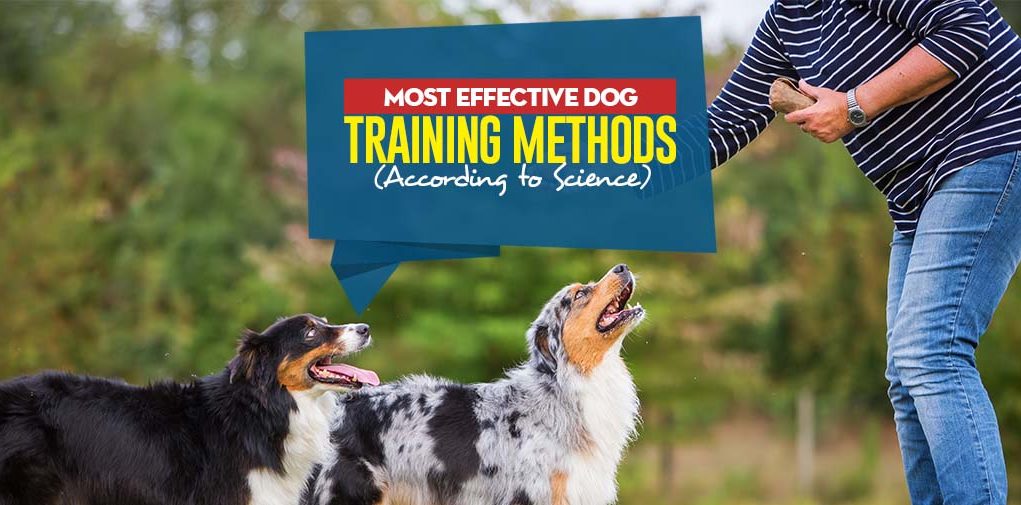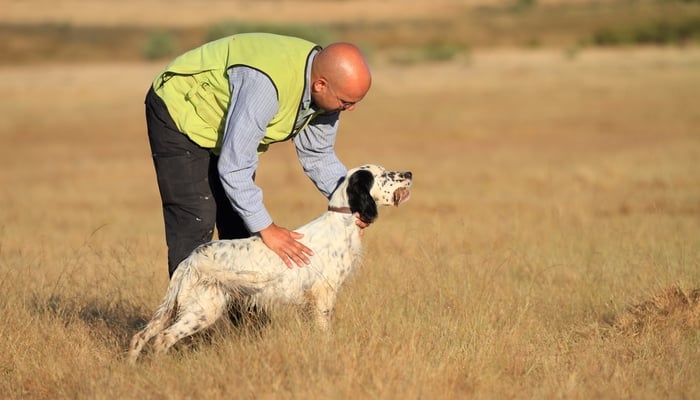Occasionally, new evidence forces us to reconsider how best to do something, even if it's a practice we've been following on a day-to-day basis.
There's no point in banging our heads against the same wall over and over again.
Teaching your pooch and finding the most effective dog training methods is one of these things that need to be revisited from time to time.
A sea of dog training information available that is supposed to help us learn is either contradictory, not based on evidence or downright makes no sense. In fact, opinions on dog training are about as varied as there are breeds of dogs.
From the Border Collie to the Bull Terrier;, from the Chow Chow to the Cocker Spaniel, there seems to be an endless array of dogs and ideas about how best to train them.
Domestic dogs (Canis familiaris) are one unified species despite their apparently immense differences in size, shape, and behavior.
Is there anything unified about the approach to dog training?
According to research (1), despite the seeming variety of dog training techniques available, everyday teaching approaches can be categorized in one of three ways:
- reward based
- punishment based
- neutral
I'll discuss these types of training and the advantages and disadvantages of each.
I'll also explain the most effective dog training methods and why they've been proven to work so well.
Remember, every dog is different, so while one training method may be effective for one dog, it's not guaranteed to work with another.
ALSO READ: The Science Behind Aggression in Dogs
4 Most Effective Dog Training Methods: here's what research shows
1. Reward-Based Training of Dogs
Reward based training provides some kind of prize for the dog who displays good behavior, such as a playing fetch, or receiving a treat (1).
In contrast to reward-based training, punishment-based training is used most often in response to “bad” behavior, such as going to the bathroom inside the house or chewing on slippers (1).
Punishments can involve physical smacking or tapping on the nose, yelling, and/or exile of the dog to their bed or outside.
Examples of neutral training include ignoring problem behaviors (like jumping on guests) or giving the dog a substitute object to chew (like a chew toy).
 Let’s separate the good from the bad.
Let’s separate the good from the bad.
Which of these is the most effective dog training method?
In this one study linked above, researchers compared obedience at seven basic tasks, including using the bathroom outside and sitting on command.
Punishment-based training was found to not be as effective as either reward-based or combination training, even for behaviors involving stealing objects or teething behaviors, which are more commonly met with punishment.
RELATED: Dog Dominance – How You Can Use It To Train Multiple Dogs
In addition, researchers have found that dogs trained with more reward-based techniques had greater measures of overall obedience.
Dogs trained using exclusively reward-based techniques were significantly more obedient than dogs trained with punishment-based techniques or a combination of the two.
In another study (2), it was found that dogs trained with more punishment-based training exhibited less interaction with strangers and less playfulness.
Moreover, owners who utilized more reward-based techniques had dogs that performed better in novel training tasks and showed an improved ability to learn.
An evidence-based blog Companion Animal Psychology has done a great breakdown on this even further, explaining the pros of reward-based dog training methods and how to utilize them.
It is thought that dogs trained using reward-based techniques are more likely to want to get it right and make efforts to please their owner.
This also makes them less likely to display learned helplessness or behavior that indicates a low sense of control of their environment.
Bottom Line: A reward-based dog training approach has been shown to lead to a more obedient, playful, and ultimately happy dog.
2. Understanding Dog Behavior During Training
A common understanding of dogs' reaction to punishment is that they are expressing a kind of guilt.
This would suggest that dogs are ruminating over their past actions and that they are aware of human moral codes.
However, studies show that this is a form of projecting human qualities onto dogs or anthropomorphism.
Dog’s appearance of guilt is actually them reacting to the body language and cues you are providing, not an internal sense of complex emotions such as guilt or shame in their actions.
To date, there is no evidence that dogs experience so-called secondary emotions such as shame or guilt (1).
Thus, it is best not to assume that the result of punishment would lead to these kinds of self-reflective emotional states.
Based on the assumption that dogs think of justice in the same way that humans do, punishment would make some sense; however this assumption has no basis.
The most effective dog training methods based on reward-based techniques have also consistently shown an increase in the welfare of dogs compared with punishment-based techniques (3).
Reward-based training techniques are also advocated for by certified applied animal behaviorists and veterinary behaviorists (4) both for their increased effectiveness as well as leading to lower levels of anxiety in the animal (5).
 When comparing the emotional effects of reward-based training and punishment-based training, Steven R. Lindsay (author of Applied Dog Behavior and Training) explains that rewards lead to greater active strategies, such as searching, exploring, and risk-taking (6).
When comparing the emotional effects of reward-based training and punishment-based training, Steven R. Lindsay (author of Applied Dog Behavior and Training) explains that rewards lead to greater active strategies, such as searching, exploring, and risk-taking (6).
In contrast, punishment tends to lead to hesitation, ritualization, risk avoidance, and generally more passive behaviors.
Punishment-based techniques have been associated with greater dog aggression (7) and more problem behaviors when compared with reward based techniques.
In addition, more frequent utilization of punishment techniques has been seen to relate to greater amounts of aggression and excitability (8).
Reward-based training is thought to increase the dog's optimism and lead to a higher likelihood of good mood, confidence, relaxation, and persistence at tasks because dogs are more likely to experience surprises (i.e. rewards) (8).
In contrast, when dogs experience greater amounts of disappointment (punishment), this is associated with irritability, anxiety, and insecurity.
Reward based training is thought to lead to a greater sense of hope in the dog, where, despite occasional disappointment, on balance, they come to expect more surprise and a greater sense of security in their environment (9). Therefore, reward-based training has been proven to be one of the most effective dog training methods
Bottom Line: Compared to punishment-based training, research shows that reward-based dog training can lead to a greater sense of security in your dog and fewer problem behaviors in the future.
3. Timing is Everything
When it comes to dog training, whichever approach is used, the make or break of an effective training and a non-effective one comes down to timing. Research shows that small delays in the timing and cues that you send your dog make a tremendous difference in how they perceive your commands.
Research shows that even a half-second delay between reward and punishment or when giving a command leads to a decrease in response to each (10 ). For example, giving your dog commands while they are distracted by something else will obviously be less effective than when they are attentive to you.
This inserts a lag between when the command is given, and when the dog begins to pay attention to what you are trying to convey.
Distracted dogs show very low performance in obedience exercises (9). In addition, it has been seen that dogs use the visual cues they receive from looking at your face and lip movements to adjust their behavior (10).
It is best to gain your dog's attention first, then issue commands because they will probably not catch the entire message the first time around, which may lead to a dissonance between expectations of what the command is for both parties.
 Dogs that are already distracted when you are trying to give them a command, are both concerned with something else as well as missing out on important information which they use to perform the command correctly in the first place.
Dogs that are already distracted when you are trying to give them a command, are both concerned with something else as well as missing out on important information which they use to perform the command correctly in the first place.
These repeated delays can compound over time, leading to rifts in communication between you and your dog. The mismatch is believed to lead to stress, anxiety, and frustration in the dog. Clear channels of communication are essential.
Being consistently responsive to your dog in terms of the timing of commands, rewards, and punishments will make communication flow much more easily. Also, gaining your dog’s attention and being mindful of the important facial and bodily cues your dog needs to understand you will lead to a greater understanding.
RELATED: 25 Most Difficult Tricks and Commands to Train Dogs (from easiest to hardest)
It turns out that, despite the assortment of dog training techniques that abound, the most effective dog training methods tend towards utilizing rewards (2, 3, 7, 8). In addition, there is a clear bridge of communication between you and your dog, resting on timing and attention (9, 10).
Research suggests that just as the great variety of dogs all converge as a single species, the varieties of dog training opinions converge on the point that attentive, reward-based training is both more effective and humane.
Bottom Line: Being consistently responsive to your dog in terms of the timing of commands, rewards, and punishments will make communication flow much more easily.
Gaining your dog’s attention as well as being mindful of the important facial and bodily cues your dogs needs to understand you will make for a greater understanding between the two of you.
 4. A Real-life Example of Reward-based Training
4. A Real-life Example of Reward-based Training
As discussed above, because your dog uses cues other than verbal cues, the best way to give commands to your dog is when it is looking at you (11).
With your dog sitting in front of you, try using a smooch or click sound to gain their attention.
According to Lindsay (6), getting and keeping your dog's attention is essential for getting him/her to learn commands and be aware of and responsive to you.
Once the dog looks up at you and makes eye contact, say “good” or use some other sign of praise while delivering a food reward and a warm pat.
Try this exercise for 5 to 10 minutes initially. Remember that the most effective dog training methods are gradual and consistent.
Continue these training sessions regularly and intermittently for several days per week.
If you sense that there is a drift in communication between you and your dog increase the sessions accordingly.
If communication is good, then consider doing less training if it is unnecessary.
The training session should be upbeat and high-spirited. Expressing an enthusiastic demeanor and a friendly face during the training will indicate your appreciation of their effort.
Gradually increase the amount of time that you expect your dog to hold your attention as well as the distance and relative location of yourself to your dog.
Try incorporating these training sessions in different locations, such as a park or a friend’s house.
Over time, you will reinforce your dog's attentiveness to you, which can help you learn more commands and develop a more responsive relationship.
This will also prove to be one of the most effective dog training methods for any canine.
Bottom Line: There are many ways to train your dog, but research suggests that an attentive, reward-based strategy will be more effective and beneficial for both you and your dog.
FAQ
What are the 4 types of dog training?
The four types of dog training are the following:
- Positive Reinforcement
- Negative Reinforcement
- Positive Punishment
- Negative Punishment
- 1 Bonus: Balanced Training (this involves rewarding for good, punishing for bad. It has been known to cause more confusion than actually being effective)
What is the rule of 7 in dog training?
This training applies to young puppies. It is a theory that was developed by Pat Schaap for socializing puppies:
By week seven of age, they should:
- be exposed to 7 different surfaces
- visited 7 different locations
- met 7 different people
- have 7 different experiences
- this means playing with dogs in 7 places
- eat in 7 different places
Final Thoughts
So there you have it. Based on science, these are the most effective dog training methods.
Let us know what you think in the comments below!
READ NEXT: 25 Best Dog Training Books for Beginning and Advanced Trainers

















